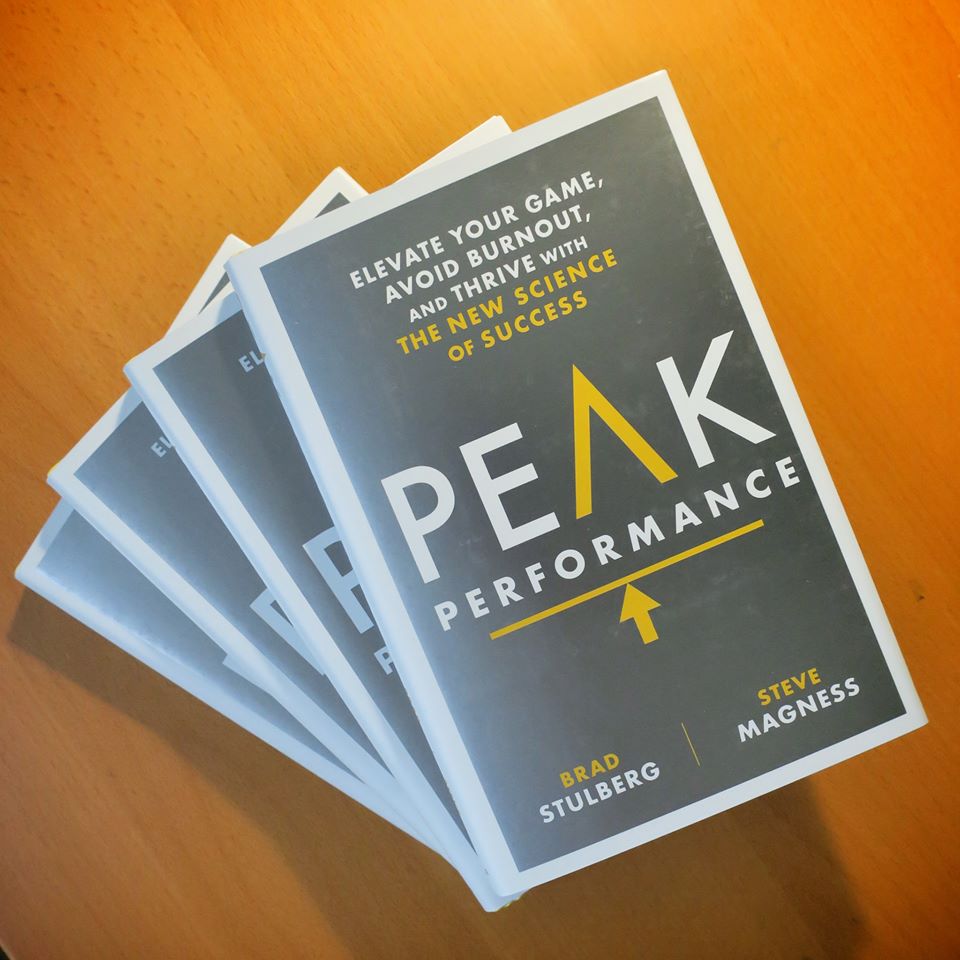A Q&A with author Brad Stulberg on his new book, Peak Performance
 Most of us are no strangers to burnout. From running PRs to your career, reaching the top of your game and staying there can seem downright impossible. But, as Brad Stulberg and co-author Steve Magness investigate in their new book, a few key factors drive performance and make staying on top possible. Peak Performance, which hit bookshelves on June 6, looks at the science behind increasing your performance while avoiding burnout.
Most of us are no strangers to burnout. From running PRs to your career, reaching the top of your game and staying there can seem downright impossible. But, as Brad Stulberg and co-author Steve Magness investigate in their new book, a few key factors drive performance and make staying on top possible. Peak Performance, which hit bookshelves on June 6, looks at the science behind increasing your performance while avoiding burnout.
I caught up with Stulberg to find out more about obtaining sustainable peak performance.
Tell me about your background with training and health.
After undergraduate school, I worked in a management consulting firm. While I grew up an athlete, I definitely wasn’t engaging in athletics as much as I wanted to be then because I didn’t have the time. After about two years there, I started to suffer from the symptoms of burnout: fatigue and loss of motivation. I decided to pivot, and for me, that meant going to public health school. At the same time as I was studying health and wellness there, I got hooked on endurance sports. I first started running in college, and after an 80-hour-a-week job, graduate school felt like vacation, so I used it as a time to get really into triathlons and running.
The fitness industry is one where professions and hobbies collide. While that means we love what we do, do you think there’s also a greater risk of burnout when our passions mix with our daily jobs?
I think it’s a blessing and a curse. Writing started as a hobby for me, and now it’s a profession. I’m happy, and I think I’d rather have a job where it’s hard to turn it off because you love it than a job where it’s hard to turn it off because you can’t turn it off.
Your book is focused on burnout and how to avoid it. Why do you feel burnout is such a risk?
There are multiple definitions of burnout. The one that I like to refer to is that burnout is when physical and mental health suffer to the point where you don’t want to do what you normally like doing. Where athletes experience burnout the most tends to be intimately related to overtraining or this notion of digging yourself into a hole with training, nutrition, and not really respecting your body or giving your body what it needs to adapt to the training.
It’s so easy to fall into this trap where you’re on a path to burnout without really even thinking about it. The temptation for driven athletes, especially for runners, tends to be to do more, more, more. That’s only made worse in this day and age with social media. People are tweeting about their killer workouts or Instagramming their 22-mile long run. And, unfortunately, there’s a lot of doping—straight up cheating. While it’s prevalent in the elite bracket, there’s all kinds of data that shows that it happens with age-groupers, too.
So there’s the mix of people sometimes doing things that are actually illegal to allow them to train beyond what’s possible, the social pressure to constantly feel like you need to be doing more just to stay in the game, and the natural hardwiring of anyone who wants to run marathons. There’s a natural inclination to want to do more. At first, it feels great because you get fitter, but over time, it’s not sustainable to constantly be pushing above your limits.
My hope for the book is that it helps individuals from all walks of life. My burnout didn’t come in athletics, it came in the corporate world. My co-author’s burnout came in running. The book was a way to figure out how to reach peak performance and sustain it.

You dedicate an entire section of your book to rest. Can you speak to its importance?
In the book, we write that it takes courage to rest. The temptation is always to do more. Especially as an athlete, you have to have a lot of self-confidence to be like, “I’ve done everything I can. I’ve done enough. Anything more will not help me and could potentially even hurt me.”
The example I like to give that makes it so real for runners is panic training the week before a marathon. It’s feeling the need on a Wednesday or Thursday before a race to do 5 x 800. Kinesiology shows that after a week, or sometimes even 10 days, there’s no adaptation to training. But the type A personality of runners makes you want to prove to yourself emotionally that you’re fit. So you go out and have this great workout, but then you’ve kind of spent your fitness on Wednesday instead of Saturday for your race.
It’s the same for other types of professionals. Burning the midnight oil feels good because it feels like you’re accomplishing more, but eventually, it catches up to you.
Do you have any tips to help make the decision to rest easier?
If you train well and have confidence in your plan, really just tell yourself that you’re going to trust your training. With that comes a mindset shift. If you look at the science of how the body and brain adapt to stimulus, you don’t actually get fitter, smarter, or more emotionally in tune while you’re doing the work. When you go do a hard training run, you’re not getting fitter while you’re running. You actually get fitter later on the couch while you’re resting or when you’re sleeping. So you have to shift how you think: The workout is applying the stimulus, but if you don’t rest, you don’t get any of the benefits of that stimulus. That subtle reframing of rest from something completely passive to something more active and beneficial has helped me.
You also focus a lot on busting stress in your book. Any advice for athletes trying to stress less?
My first piece of advice is run without a device. I’m a type A, OCD, stereotypical runner, and what I’ve found is that on the runs that I don’t have a watch, I feel so much better during and after. It’s freeing, but you really have to let go of tracking the usuals like pace, heart rate, and distance. If it’s a tempo run, do what feels like a tempo run. If it’s an easy run, do what your body feels like it needs to rejuvenate. Physiologically, it’s good because you meet your body exactly where it is instead of trying to force it into something it may or may not want to be. Sociologically, running is so beautiful and fun when you can be completely present in the act of running, especially when you’re in nature, instead of constantly looking at your watch and trying to adjust your pace.
The second: In the book, we call this being a minimalist vs. a maximalist, which is this notion of trying to cut out the trivial stuff in your life. If you find things that are causing you stress, but are really rather pointless when you step back and look at them, just forget about those things. More practically, think about decision picking. Instead of making minuscule decisions (ie: what clothes to wear, what to eat for lunch, etc.), automate them. It seems trivial, but research shows that, like any other muscle, your brain fatigues over the course of a day. The more decisions you have to make, the more that your brain fatigues. Eliminate the trivial stuff so that your brain has more power for decisions that matter.
Similar to running without a watch, it’s good to disconnect from our smartphones. There’s so much research around how refreshing it can be, not only to turn it off, but also to not even have a smartphone with you at all. That way, you’re not even thinking about the potential that you’re getting an email or notification. Research shows that time spent in nature is good to help turn off the body’s stress response, but it’s not nearly as effective—and in some cases, it even loses its value—when you’ve got your phone with you. To help, I’ve tried to work in a weekly nature walk. I’m not running. I’m simply walking in nature, and my phone stays in the car. It’s all about making what you’re really trying to do the easy thing to do.
Is there one type of mindfulness exercise that you’d recommend for everyone?
Meditation is extremely powerful, and that’s an understatement. I didn’t meditate before I wrote the book, and neither did my co-author. When we dove into the research, we found that meditation really does help strengthen your mind and helps you make decisions in stressful situations. I would recommend a meditation practice.
That said, it’s kind of tricky. I’d be lying if I said I meditated every day. I probably had about three false starts during the writing of this book. I just didn’t stick with it. So, for me, because I do so many runs without a watch and I never run with music or a podcast anymore, I consider that a moving meditation.
If you think about the benefits of meditation, the benefits of running are similar. A lot of meditation is helping you practice being OK with being uncomfortable. A huge benefit of endurance sports is when you’re in the middle of a hard workout and you’re uncomfortable, you can freak out or you can practice acknowledging the pain. Rather than having an emotional response, sit with the discomfort, make it to the next mile, and reevaluate.
